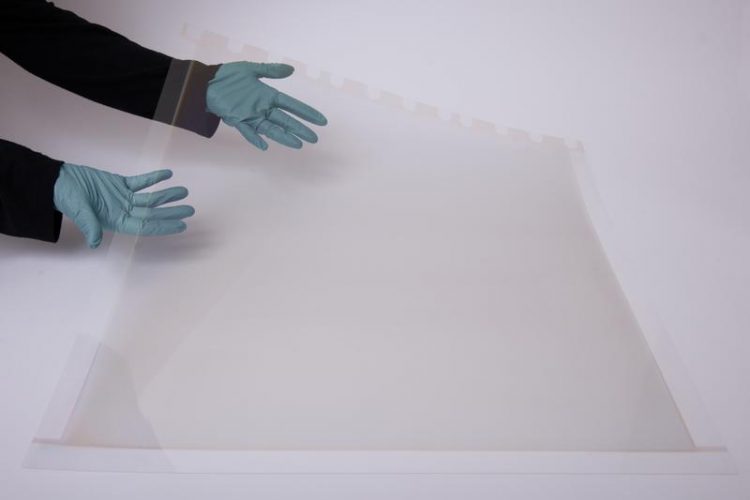Flash lamp annealing: Energy-effective process for efficient annealing of large-area substrates

ITO layer treated with FLA on ultra-thin glass © Fraunhofer FEP Picture in printable resolution: www.fep.fraunhofer.de/press
Thermal treatment of coated glass, plastics and wafers is a common process for improving the layer and surface properties of large-area substrates. In conventional furnace-annealing processes, the entire substrate is heated and must cool down slowly after the treatment. This is time and energy intensive and can be problematic for treating large substrate areas.
In addition, long thermal processes for thin-film technology lead to undesirable diffusion phenomena and may therefore require additional diffusion suppressing barrier layers. The production process thus becomes more complex. Flash lamp annealing (FLA) offers a good alternative to conventional furnace annealing for the optimization of film properties, e. g. electrical and optical properties, especially on large-area substrates.
FLA is an innovative process for thermal pre- and post-treatment of functional coatings and sensitive substrates using xenon flash lamps working in a time period of only a few milliseconds. A significant advantage compared to conventional processes is the application of thermal energy to a restricted a local area on the substrate (such as just the surface, for example).
This reduces the thermal load and hence the temperature throughout the entire substrate. Thus, this process is more efficient and less expensive compared to furnace processes. Due to the small footprint of the FLA setup, this process can be implemented into almost any production line. Moreover, FLA is less energy-intensive, which results in a reduction of CO2 emissions.
In collaboration with ROVAK GmbH, researchers of the Fraunhofer FEP are investigating and experimenting with new electrical circuit designs for energizing flash lamps as well as for enhancing process control and measurement technology. ROVAK's know-how in the field of technology and system development for pulsed high-power flash lamps provides the foundation for this advanced work.
Dr. Manuela Junghähnel, head of the Sheet-to-Sheet Technologies and Precision Coating department at Fraunhofer FEP, explains: “We have focused on inline FLA. Our investigations have enabled us to treat large surface areas under conditions of continuous operation.
Treatment speeds of up to 6 meters per minute and widths of up to 3.2 meters are feasible. This annealing method primarily treats just the regions close to the surface. It also allows the processing of temperature-sensitive materials, whereat a maximum surface temperature of up to 2,000°C can be achieved.”
Operation of long flash lamps (up to 1000 mm) was investigated for treating large substrate areas. The difficulty was to ensure a safe and reproducible flash operation, since a reliable flash ignition as well as a uniform distribution of the deposited energy density are necessary characteristics for high-quality treatment. In addition, handling the high currents and voltages that occur in the millisecond range for the FLA process posed a challenge.
Effective process control is necessary for using FLA in industrial applications. To accomplish this, a measuring system has been investigated to record the temperature profile of the surface during treatment using time-resolved emission detection. This allows the exact determination of the annealing effect of each individual flash.
FLA in its conventional form has already reached the marketability stage. After completion of the investigations at the Fraunhofer FEP, the results of the project will be able to be used by ROVAK to launch FLA systems adapted for efficient, large-area treatment.
about the project:
Co-funded by tax revenue on the basis of the budget adopted by the members of the Saxon State Parliament.
Funded by the Saxon State Ministry for Economics, Labour and Transport
Funding reference: 100349243/3698
Project partner
ROVAK GmbH
Grumbach
www.rovak-flash-lamp.com
Fraunhofer FEP at the ICCG13
March 23– 26, 2020 in Braunschweig
https://13.iccg.eu
Booth No.: C1
Techtalks:
March 24, 2020, Session 3
Film growth metrology, process control, simulation
Recent developments in dynamic flash lamp annealing for ultra-fast thermal annealing
of large substrate areas
Thomas Preußner, Fraunhofer FEP
16:10 PM – 16:30 PM
March 24 – 25 2020, Session 4
Energy conversion, lighting, displays
Chairpersons: Dr. Manuela Junghähnel (Fraunhofer FEP), Dr. D. Bernt
Poster:
March 26, 2020
Posters will be on display throughout the conference. Poster presentations by the
authors will take place on Tuesday afternoon, March 26.
Press contact:
Mrs. Annett Arnold
Fraunhofer Institute for Organic Electronics, Electron Beam and Plasma Technology FEP
Phone +49 351 2586 333 | presse@fep.fraunhofer.de
Winterbergstraße 28 | 01277 Dresden | Germany | www.fep.fraunhofer.de
Media Contact
All latest news from the category: Life Sciences and Chemistry
Articles and reports from the Life Sciences and chemistry area deal with applied and basic research into modern biology, chemistry and human medicine.
Valuable information can be found on a range of life sciences fields including bacteriology, biochemistry, bionics, bioinformatics, biophysics, biotechnology, genetics, geobotany, human biology, marine biology, microbiology, molecular biology, cellular biology, zoology, bioinorganic chemistry, microchemistry and environmental chemistry.
Newest articles

Superradiant atoms could push the boundaries of how precisely time can be measured
Superradiant atoms can help us measure time more precisely than ever. In a new study, researchers from the University of Copenhagen present a new method for measuring the time interval,…

Ion thermoelectric conversion devices for near room temperature
The electrode sheet of the thermoelectric device consists of ionic hydrogel, which is sandwiched between the electrodes to form, and the Prussian blue on the electrode undergoes a redox reaction…

Zap Energy achieves 37-million-degree temperatures in a compact device
New publication reports record electron temperatures for a small-scale, sheared-flow-stabilized Z-pinch fusion device. In the nine decades since humans first produced fusion reactions, only a few fusion technologies have demonstrated…





















